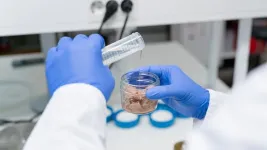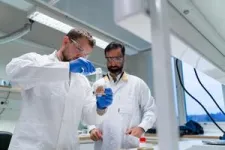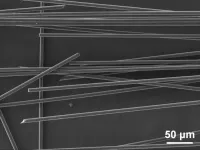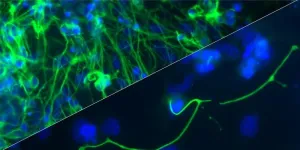(Press-News.org) Fish is a high-quality source of protein, containing omega-3 fatty acids and many other beneficial nutrients. However, the accumulation of toxic mercury also makes fish consumption a concern, of which tuna is particularly susceptible. Researchers from Chalmers University of Technology in Sweden have come up with a novel approach to packaging canned tuna infused in the water-based solution of amino acid cysteine. It was shown to remove up to 35 percent of the accumulated mercury in canned tuna, significantly reducing human exposure to mercury via food.
Fish and other seafood, provide people with a broad variety of essential nutrients in their diet However, the consumption of some fish also exposes people to the most hazardous form of mercury, methylmercury. This accumulates in fish (especially those species higher up the food chain, such as tuna) as it binds to proteins in the tissues.
Packaging solution draws out the mercury
According to the World Health Organisation (WHO), mercury is one of the ten most harmful chemicals for humans. Exposure can damage the central nervous system, with foetuses and young children being particularly sensitive to the effects. That is why dietary recommendations for pregnant women advise caution with tuna consumption.
“Our study shows that there are alternative approaches to addressing mercury contamination in tuna, rather than just limiting consumption. Our goal is to improve food safety and contribute to enhanced human health, as well as to better utilise food that is currently under certain restrictions,” says Mehdi Abdollahi, Associate Professor at the Department of Life Sciences at Chalmers and coordinator of a project called Detoxpak.
The concept of so-called active packaging is to develop materials, for example a liquid inside a can, that interact with food during storage − for instance, to increase the shelf life. However, this concept has never previously been used to improve food safety.
In a previous study, the researchers investigated the possibility of coating packages with thiolated silica to capture mercury from canned fish. What they observed, was that the forces binding the mercury within the tuna tissue prevented it from being released.
Proteins in tuna tissues, particularly sulfur-containing amino acids, strongly bind and accumulate mercury due to the strong interactions involving thiol groups from these amino acids. "By knowing that, we decided to add one of them, cysteine, to a water solution in which fish meat can be immersed. We believed this would allow some of the mercury to be drawn out and instead bind to the solution and be discarded. Further research is needed to take care of the removed mercury,” says Przemysław Strachowski, first author, and at the time of study, a postdoc at the Department of Life Sciences at Chalmers.
Up to 35 percent of mercury removed
In the study, the researchers discovered that the greater the surface area of fish flesh in contact with the cysteine solution, the higher the mercury uptake. The highest value of mercury reduction, 35 percent, was reached when testing canned minced tuna, from regular grocery stores. They also discovered a maximum threshold of two weeks, after which no further changes occurred.
In the current study, however, the researchers did not observe any noticeable changes in appearance or smell of the tested fish samples. Cell-based assays have also proven the safety of the developed technology.
“The beauty of this type of packaging is that it is active while the product is on the shelf. No additional production steps would be needed if a method like this were used industrially. The application of our results could increase the safety margin for fish consumption,” says Przemysław Strachowski.
More about the scientific study:
Read the study New Insight into Mercury Removal from Fish Meat Using a Single-Component Solution containg Cysteine in Global Challenges.
The authors are Przemysław Strachowski and Mehdi Abdollahi, the Department of Life Sciences, Chalmers University of Technology, Romain Bordes, the Department of Chemistry and Chemical Engineering, Chalmers University of Technology, Geeta Mandava and Johan Lundqvist, Swedish University of Agricultural Sciences.
The study was funded by Formas
More about the method:
In the study, fish protein extracts in the form of dry powder, fresh and lab-steamed fish in fillet and mince forms, and commercially available samples of canned tuna, both in larger pieces and as minced fish, were used.
No extra additives, like pH modifiers, were needed for this process. Only the cysteine concentration was adjusted in the water. Increasing cysteine levels improved mercury removal, but only up to a certain point. A 1.2 percent concentration level was optimal.
For more information please contact:
Mehdi Abdollahi, Associate Professor at the Department of Life Sciences, Chalmers University of Technology, Sweden, khozaghi@chalmers.se +46 31 772 38 23
Przemyslaw Strachowski, former Postdoctoral Researcher at the Department of Life Sciences, Chalmers University of Technology, Sweden, pawelpr@chalmers.se
The contact persons both speak English. Mehdi Abdollahi also speaks Persian and Przemyslaw Strachowski speaks Polish. They are available for live and pre-recorded interviews. At Chalmers, we have podcast studios and broadcast filming equipment on site and would be able to assist a request for a television, radio or podcast interview.
Banner image caption: In the image you can see one of the researchers pouring the liquid amino acid cysteine into a jar of canned tuna. The study showed that this novel ‘active packaging’ technique removed up to 35 percent of the accumulated mercury in canned tuna, significantly reducing human exposure to mercury via food.
Banner image credit: Chalmers University of Technology I Hanna Magnusson
All images related to this press release can be downloaded via this link. END
Mercury content in tuna can be reduced with new packaging solution
2025-02-06
ELSE PRESS RELEASES FROM THIS DATE:
Recycling the unrecyclable
2025-02-06
Epoxy resins are coatings and adhesives used in a broad range of familiar applications, such as construction, engineering and manufacturing. However, they often present a challenge to recycle or dispose of responsibly. For the first time, a team of researchers, including those from the University of Tokyo, developed a method to efficiently reclaim materials from a range of epoxy products for reuse by using a novel solid catalyst.
There’s a high chance you are surrounded by epoxy compounds as you read this. They are used in electronic devices due to their insulating ...
Alien ocean could hide signs of life from spacecraft
2025-02-06
Searching for life in alien oceans may be more difficult than scientists previously thought, even when we can sample these extraterrestrial waters directly.
A new study focusing on Enceladus, a moon of Saturn that sprays its ocean water into space through cracks in its icy surface, shows that the physics of alien oceans could prevent evidence of deep-sea life from reaching places where we can detect it.
Published today (Thursday, 6 February 2025) in Communications Earth and Environment, the study shows how Enceladus's ocean forms distinct layers that dramatically slow the movement of material ...
Research unveils new strategies to tackle atrial fibrillation, a condition linked to stroke and dementia risks
2025-02-06
A recent Brazilian study published in Nature Cardiovascular Research has highlighted promising pathways for preventing and treating atrial fibrillation, a condition that significantly raises the risks of stroke and dementia. The research was led by the Federal University of Rio de Janeiro (UFRJ) in partnership with the D’Or Institute for Research and Education (IDOR).
What Is Atrial Fibrillation?
Atrial fibrillation (AF) is the most common cardiac arrhythmia worldwide. It disrupts the normal rhythm of the heart, causing irregular and often rapid heartbeats. This condition is associated with increased risks of stroke, dementia, and heart failure. It is also linked to other health ...
Research spotlight: Researchers identify potential drug targets for future heart failure therapeutics
2025-02-06
How would you summarize your study for a lay audience?
Heart failure remains a substantial burden for patients due to its high prevalence and limited therapeutic options. Heart failure is classified into two major clinical subtypes— heart failure with preserved ejection fraction (HFpEF) and heart failure with reduced ejection fraction (HFrEF). While there have been significant therapeutic advances in HFrEF, the rate of complications and death from HFrEF remains high. Additionally, most drugs that have shown benefits for patients with HFrEF have not demonstrated a comparable benefit in patients with HFpEF, highlighting a critical need for the development of targeted therapies ...
Air pollution clouds the mind and makes everyday tasks challenging
2025-02-06
People’s ability to interpret emotions or focus on performing a task is reduced by short-term exposure to particulate matter (PM) air pollution, potentially making everyday activities, such as the weekly supermarket shop, more challenging, a new study reveals.
Scientists discovered that even brief exposure to high concentrations of PM may impair a person’s ability to focus on tasks, avoid distractions, and behave in a socially acceptable manner.
Researchers exposed study participants to either high levels of air pollution - using candle smoke - or clean air, testing cognitive abilities ...
Uncovering how developmental genes are held in a poised state
2025-02-06
Key points:
Researchers from the Voigt lab have extended our understanding of how developmental genes are held in a poised state to allow timely expression once they receive the correct ‘go’ signals.
The next layer of regulation has been uncovered by the identification of proteins that interact with the epigenetic marks that poise developmental genes ready for expression.
The research provides insight into the mechanisms through which the phenomenon of bivalency – where both activating and repressive marks are laid down at the same site on the genome – acts to ready developmental ...
Multimillion-pound research project aims to advance production of next-generation sustainable packaging
2025-02-06
A multimillion-pound research project, called SustaPack, aims to overcome manufacturing challenges for the next generation of sustainable, paper-based packaging for liquids. Backed by a £1 million grant from the Engineering and Physical Sciences Research Council (EPSRC) as part of UKRI’s co-investing programme, packaging technology company Pulpex Ltd has joined forces with the University of Surrey to refine its manufacturing processes to provide a viable solution to plastic pollution.
Contributing matching support towards the project, Pulpex has already made significant strides in the development of its patented technology, ...
‘Marine Prosperity Areas’ represent a new hope inconservation
2025-02-06
Could 2025 be the year marine protection efforts get a “glow up”? According to a team of conservation-minded researchers, including Octavio Aburto of UC San Diego’s Scripps Institution of Oceanography, the moment has arrived.
In a new study published Feb. 6 in the journal Frontiers in Marine Science, Aburto and a multinational team of marine scientists and economists unveil a comprehensive framework for Marine Prosperity Areas, or MPpAs. With a focus on prosperity—the condition ...
Warning signs may not be effective to deter cannabis use in pregnancy: Study
2025-02-06
PISCATAWAY, NJ – Warning signs at dispensaries about the potential health effects of cannabis use in pregnancy may not be effective, according to a new report in the Journal of Studies on Alcohol and Drugs, based at Rutgers University. In fact, those who are pregnant and using cannabis may actually distrust the content of warning signs altogether.
“Mandatory warning signs aren’t working,” says lead researcher Sarah C. M. Roberts, DrPH, of the University of California, San Francisco. In fact, some of the respondents “saw the signs as having stigmatizing or negative effects on pregnant people who use ...
Efforts to find alien life could be boosted by simple test that gets microbes moving
2025-02-06
Finding life in outer space is one of the great endeavors of humankind. One approach is to find motile microorganisms that can move independently, an ability that is a solid hint for life. If movement is induced by a chemical and an organism moves in response, it is known as chemotaxis.
Now, researchers in Germany have developed a new and simplified method for inducing chemotactic motility in some of Earth’s smallest life forms. They published their results in Frontiers in Astronomy and Space Sciences.
“We tested three types of microbes – two bacteria and one type of archaea – and found that they all moved toward a chemical called L-serine,” ...







